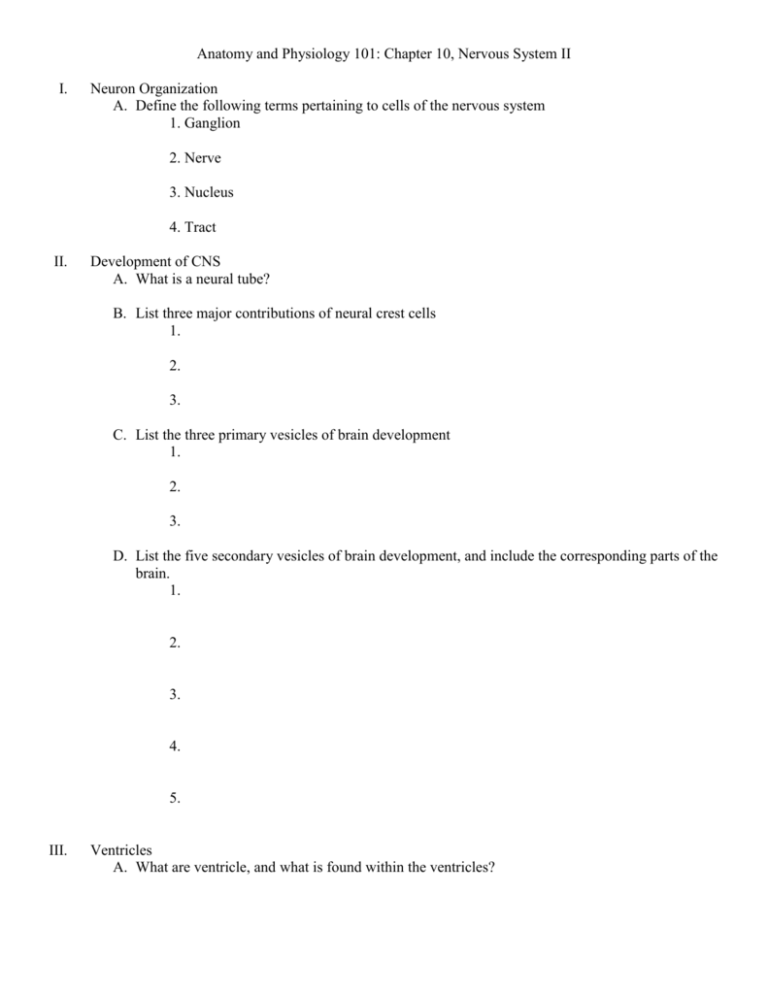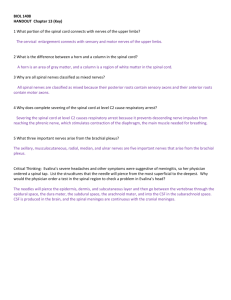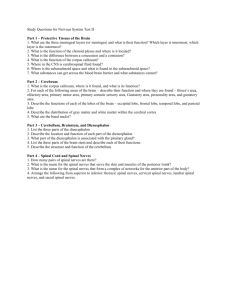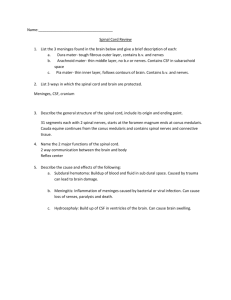Chapter 11
advertisement

Anatomy and Physiology 101: Chapter 10, Nervous System II I. Neuron Organization A. Define the following terms pertaining to cells of the nervous system 1. Ganglion 2. Nerve 3. Nucleus 4. Tract II. Development of CNS A. What is a neural tube? B. List three major contributions of neural crest cells 1. 2. 3. C. List the three primary vesicles of brain development 1. 2. 3. D. List the five secondary vesicles of brain development, and include the corresponding parts of the brain. 1. 2. 3. 4. 5. III. Ventricles A. What are ventricle, and what is found within the ventricles? B. List the locations of the four ventricles 1.1st 2.2nd 3.3rd 4.4th C. The third are fourth ventricle are connected by the _______________ _______________ D. Identify the capillaries that line the ventricles (from the pia mater). What type of neuroglia are these capillaries lined with? E. What is the function of Cerebrospinal Fluid (CSF)? IV. Meninges A. List the three layers of the meninges 1. 2. 3. B. The space beneath the arachnoid mater is called the _________________ ____________, and is filled with ________________________. C. A spinal tap or saddle block is usually given at which level of the vertebrae? V. Spinal Cord A. Where does the spinal cord begin, and where does it end? B. Identify the two enlargements on the spinal cord, and indicate which nerves are supplied from these enlargements. C. How many spinal nerves extend from the spinal cord? Indicate the total number of paired spinal nerves, and list the appropriate number for each region of the spinal cord. D. What is the cauda equina? E. Draw a cross section of the spinal cord and label the major structures. Indicate the grey matter and the White matter. F. Label the following: Anterior, Lateral, and Posterior Horns; Anterior, Lateral, and Posterior funiculi; central canal; grey commissure; ventral root; dorsal root; anterior median fissure and posterior median sulcus. G. Give a function for each of the following parts of a spinal cord 1.Grey matter 2. Grey Commissure 3. Funiculi (Funiculus) 4. Central Canal 5. Ventral Root 6. Dorsal Root 7. Dorsal Root Ganglion VI. Reflexes A. What is a reflex? B. Illustrate a simple reflex arc. Include the five major parts of a reflex arc, and illustrate the direction of the nerve impulse. VII. Ascending/Descending Tracts A. Distinguish between an ascending and a descending tract. Which are motor, which are sensory? B. Most tracts decussate. What does this mean? C. Explain the functions of the following ascending tracts. 1.Fasciculus gracilis and Fasciculus cuneatus 2. Lateral Spinothalamic tract 3.Anterior Spinothalamic tract 4. Spinocerebellar tracts D. Give the location for the three neurons in the fasciculus cuneatus tract 1. 2. 3. E. Where does the fasciculus cuneatus tract decussate? F. Explain the functions of the following descending tracts. 1.Corticospinal Tracts 2.Rubrospinal tract G. Where do most (85%) of descending tracts decussate? VIII. Brain A. Medulla Oblongata 1.Indicate the location of the medulla oblongata: 2. Name three important nuclei in the medulla oblongata, and give a function for each. 3.What are medullary pyramids? 4.What are olives? B. Pons 1.What are the two major types of fibers in the pons and where do they connect? 2. Name two important nuclei within the pons. C. Cerebellum 1.Provide three functions of the cerebellum 1. 2. 3. 2.Explain how the 3 cerebellar peduncles transmit information for smooth movements 1. Inferior Peduncle: 2. Middle Peduncle: 3. Superior Peduncle: 3.What is the function of the Dentate Nucleus? D. Midbrain 1.What are the functions of the superior and inferior colliculi of the corpora quadrigemina. 2. What are the cerebral peduncles, and where are they located? 3.What is substantia nigra? What neurotransmitter is released from the substantia nigra, and what role does it play? E. Diencephalon 1.List three major structures of the Diencephalon 1. 2. 3. 2.What is secreted by the Pineal Gland? What is its function? 3.Give two functions of the Thalamus 1. 2. 4.Give 7 functions of the Hypothalamus 1. 2. 3. 4. 5. 6. 7. F. Basal Nuclei 1.How many nuclei form the basal nuclei? 2.What is the function of Basal Nuclei? 3.What neurotransmitter is secreted from the basal nuclei? 4.How are the basal nuclei and substantia nigra affected by Parkinson’s Disease? List two symptoms of Parkinson’s disease. IX. Cerebrum A. Overview 1.Distinguish between gyri (gyrus) and sulci (sulcus) 2. Distinguish between the cerebral cortex and medulla. B. Frontal Lobe 1.Which portion of the frontal lobe is responsible for motor speech activities? 2.List four activities performed by the association areas within the frontal lobe. 1. 2. 3. 4. C. Parietal Lobe 1.Lists four types of sensations processed in the parietal lobe 1. 2. 3. 4. 2.Which portion of the parietal lobe is responsible for sensory speech, and speech association (understanding written and spoken language)? D. Occipital Lobe 1.Identify the major sensory cortex and association area located within the occipital lobe. E. Temporal Lobe 1.What are the two major sensory inputs processed in the temporal lobes? 2.What type of memory is processed in the association areas of the temporal lobes? X. Limbic System A. Identify four roles of the limbic system 1. 2. 3. 4. B. What sense provides the major stimulus of the limbic system? C. Describe the function of the cingulate gyrus, and what happens when it is damaged? D. What are two roles of the hippocampus? What disease results in a significant degeneration of the hippocampus? E. What is the major role of the amygdala? XI. Overview of PNS A. How many cranial nerves and how many spinal nerves make up the PNS? B. Illustrate a basic cross section of a peripheral nerve. Include the fascicles and the three layers of connective tissue coatings. C. What are the three types of peripheral nerves, based on the fibers they contain? XII. Cranial Nerves: List the 12 Pairs of Cranial Nerves. Indicate the Roman numeral, the name, major functions (and branches when necessary) for each. 1. 2. 3. 4. 5. *Cranial Nerve and three branches 6. 7. 8. *Cranial Nerve and two branches 9. 10. 11. 12. XIII. Spinal Nerves A. Indicate the number of pairs of spinal nerves for each section of the spinal cord 1.Cervical = 2.Thoracic = 3.Lumbar = 4.Sacral = 5.Coccygeal = B. Which spinal nerves make up the cervical plexus? C. What major nerves arise from the cervical plexus, and what is their function? D. Which spinal nerves make up the brachial plexus? E. List three major nerves that arise from the brachial plexus. Include their functions, and indicate any conditions that may result from damage. 1. 2. 3. F. What spinal nerves make up the lumbosacral plexus? G. List three nerves that arise from the lumbosacral plexus. 1. 2. 3. H. Which nerves do not form a plexus? What nerves arise from this section, and what are their functions?






